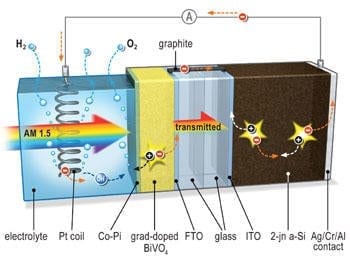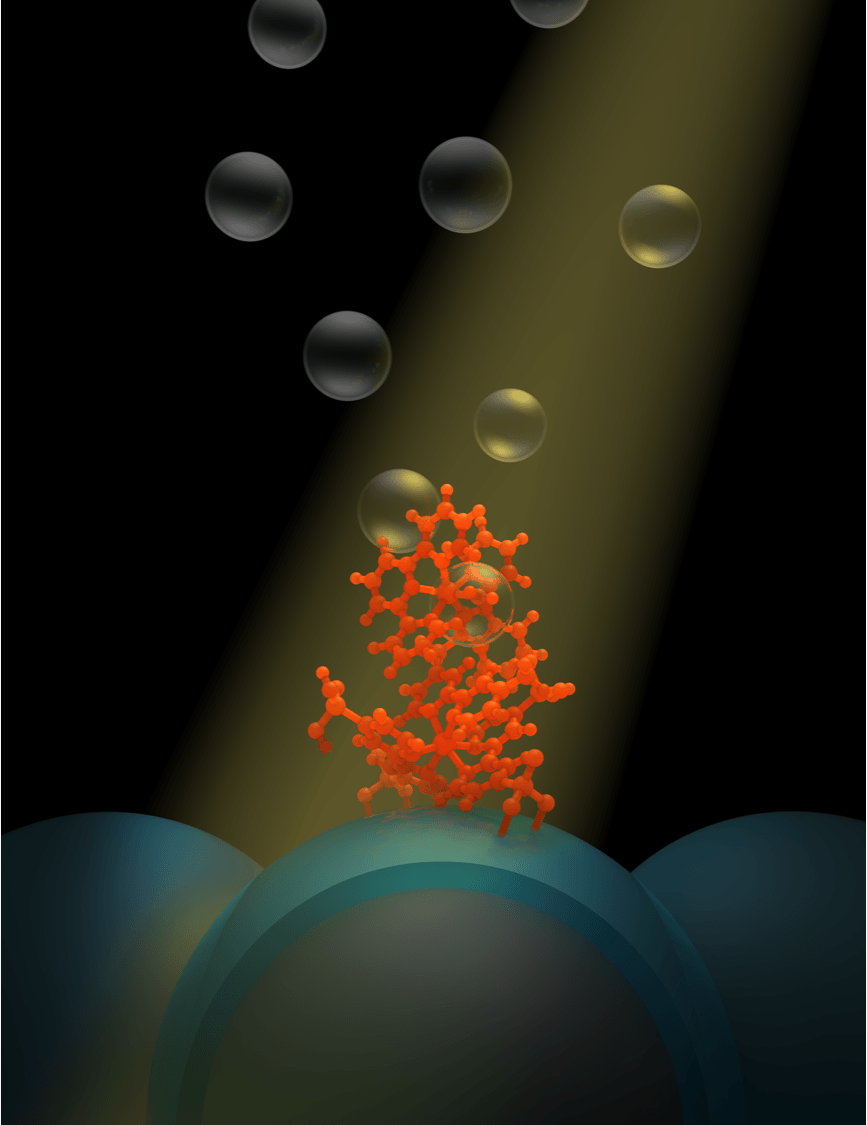
“We’ve just created a cost-effective, highly stable, and highly efficient solar fuel device.”
Using a simple solar cell and a photo anode made of a metal oxide, HZB and TU Delft scientists have successfully stored nearly 5% of solar energy chemically in the form of hydrogen. This is a major feat as the design of the solar cell is much simpler than that of the high-efficiency triple-junction cells based on amorphous silicon or expensive III-V semiconductors that are traditionally used for this purpose. The photo anode, which is made from the metal oxide bismuth vanadate (BiVO4) to which a small amount of tungsten atoms was added, was sprayed onto a piece of conducting glass and coated with an inexpensive cobalt phosphate catalyst.
“Basically, we combined the best of both worlds,” explains Prof. Dr. Roel van de Krol, head of the HZB Institute for Solar Fuels: “We start with a chemically stable, low cost metal oxide, add a really good but simple silicon-based thin film solar cell, and—voilà—we’ve just created a cost-effective, highly stable, and highly efficient solar fuel device.”
Thus the experts were able to develop a rather elegant and simple system for using sunlight to split water into hydrogen and oxygen. This process, called artificial photosynthesis, allows solar energy to be stored in the form of hydrogen. The hydrogen can then be used as a fuel either directly or in the form of methane, or it can generate electricity in a fuel cell. One rough estimate shows the potential inherent in this technology: At a solar performance in Germany of roughly 600 Watts per square meter, 100 square meters of this type of system is theoretically capable of storing 3 kilowatt hours of energy in the form of hydrogen in just one single hour of sunshine. This energy could then be available at night or on cloudy days.
The Latest Bing News on:
Solar hydrogen production
- Countrywide locks in government backing to help drive Hydrogen HyWayon May 13, 2024 at 5:24 pm
Countrywide Hydrogen’s ambition to be the first major green hydrogen producer in Tasmania has received a boost with the state government announcing an $8 million funding package that would support the ...
- Is SoCalGas hydrogen testing in Orange Cove dangerous, or smart for the environment?on May 13, 2024 at 12:22 pm
The Southern California Gas Company (SoCalGas) wants to test hydrogen fuel in Orange Cove, a small enclave in the western Fresno County foothills, but some activists are against the plan because it is ...
- Thyssenkrupp Nucera to Supply Cepsa With Electrolyzer for Green-Hydrogen Plant in Spainon May 13, 2024 at 4:00 am
By Andrea Figueras Thyssenkrupp Nucera said it was chosen by Spanish energy company Cepsa to supply a 300-megawatt electrolyzer for a green-hydrogen plant ...
- Somssich: Green hydrogen essential for energy revolutionon May 12, 2024 at 2:00 am
In fact, Green Hydrogen (G-H2) will be a very essential player worldwide helping to decarbonize many energy sectors that other technologies aren’t able to address. That is why I am encouraged to hear ...
- Off-grid solar-wind power plant design for green hydrogen generationon May 10, 2024 at 5:19 am
Scientists in Czechia have conducted a techno-economic analysis of a green hydrogen production system powered exclusively by photovoltaic and wind energy. The system uses surplus energy for water ...
- ‘Green’ hydrogen energy production just got a lot easieron May 10, 2024 at 3:03 am
RIKEN scientists paired iridium with manganese oxide to maintain green hydrogen production for 3,000 hours at 82% efficiency.
- Solar EV charging solution to grid constraintson May 9, 2024 at 11:47 am
As constrained grids potentially hamper EV charging, renewable off-grid microgrids may present a solution, finds research from IDTechEx.
- California’s Dream of a Green Hydrogen Future Could Backfireon May 9, 2024 at 2:30 am
Backers argue that California must move quickly to reap the benefits of federal incentives. Guidelines for the hydrogen hub money require states to build up their supply and delivery of clean hydrogen ...
- Solar Energy Newson May 8, 2024 at 5:00 pm
Pairing Crypto Mining With Green Hydrogen Offers Clean Energy ... 2024 — Which process is best suited for mass production of perovskite solar cells? While solvent-based manufacturing processes ...
- Will making hydrogen ‘green’ depend on China?on May 6, 2024 at 3:54 am
Machinery that makes hydrogen fuel from water could become another energy technology whose production is centered in Asia.
The Latest Google Headlines on:
Solar hydrogen production
[google_news title=”” keyword=”Solar hydrogen production” num_posts=”10″ blurb_length=”0″ show_thumb=”left”]
The Latest Bing News on:
Solar fuel device
- New free analysis platform shines light on how solar energy projects will affect utilities' power systemson May 13, 2024 at 1:02 pm
Researchers at the Department of Energy's Oak Ridge National Laboratory, in collaboration with three other national labs, have developed a free online platform to help utilities understand how solar ...
- Powering Solutions for Your Drone in 2024: New Fuelson May 13, 2024 at 6:01 am
In the first part of this three-part series, we explored different electric powering solutions for drones. Now, the focus is on new fuels, such as hydrogen fuel cells and solar panels, and how their u ...
- Gaskin: Community Solar powers up for energy ownershipon May 12, 2024 at 7:51 am
The Boston Community Solar Cooperative recently held a ribbon-cutting ceremony, marking a potential turning point in the renewable energy sector: community ownership of an electricity generation ...
- Solar Power Now Leads the Charge Towards Sustainable Energy Futureon May 10, 2024 at 2:58 pm
As the demand for renewable energy grows ever higher, Solar Power Now emerges as a frontrunner in driving the transition towards a sustainable ...
- Are Solar Panels Worth It?on May 9, 2024 at 4:59 pm
Solar energy systems can provide numerous environmental ... and certain energy storage devices. These tax credits can help reduce the federal income taxes you will owe to the IRS.
- Best Solar Panels For Homes Of 2024on May 9, 2024 at 12:46 pm
Commissions do not affect our editors' opinions or evaluations. Solar panels and their accessories unlock the boundless energy from sunshine and transform it into useful energy at home.
- Solar Energy Newson May 8, 2024 at 5:00 pm
The new device is composed by a highly transparent ... 2024 — New research suggests that there might be other ways to generate solar energy than just trying to make individual solar cells ...
- A low-energy process for high-performance solar cells could simplify the manufacturing processon May 8, 2024 at 7:39 am
Finding reliable, eco-friendly power sources is crucial as our world grapples with increasing energy needs and the urgent call to combat climate change. Solar energy offers one solution, with ...
- Low-energy process for high-performance solar cellson May 7, 2024 at 3:50 pm
Finding reliable, eco-friendly power sources is crucial as our world grapples with increasing energy needs and the urgent call to combat climate change. Solar energy offers one solution, with ...
- Georgia Joins Regional and National Trend by Enacting State Law to Regulate Decommissioning of Solar Farmson May 7, 2024 at 9:27 am
Solar power facility' means “a solar energy device [excluding those of retail customers], or the integrated collection of such devices, together with any equipment or other personal property and ...
The Latest Google Headlines on:
Solar fuel device
[google_news title=”” keyword=”solar fuel device” num_posts=”10″ blurb_length=”0″ show_thumb=”left”]












